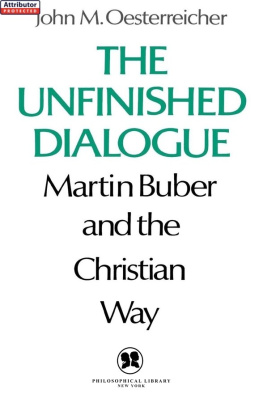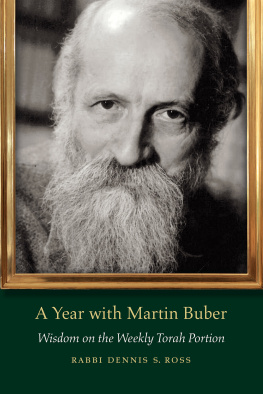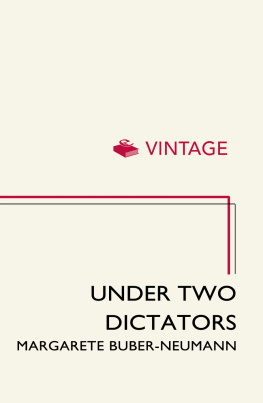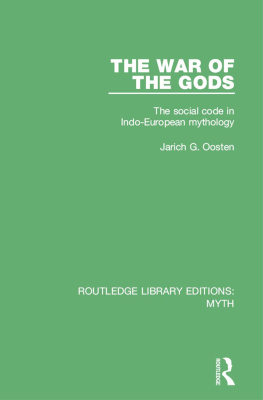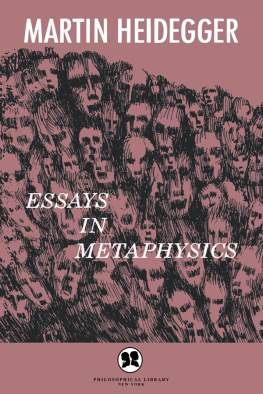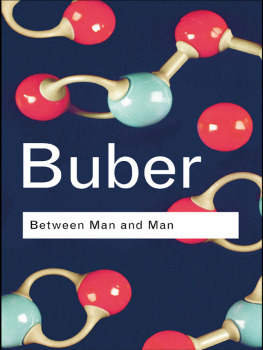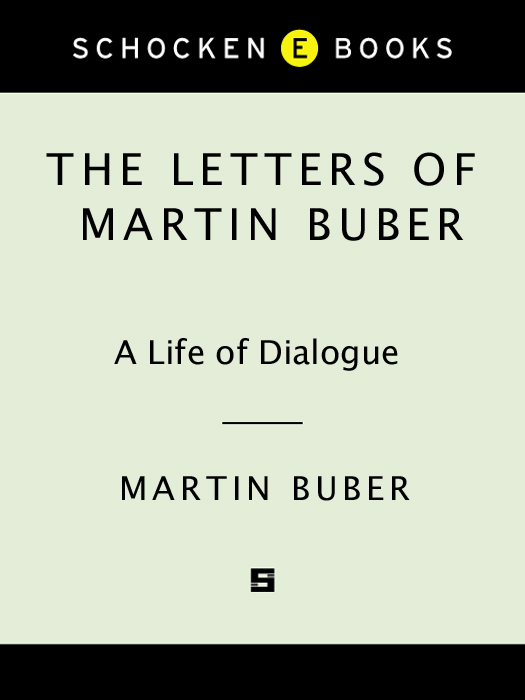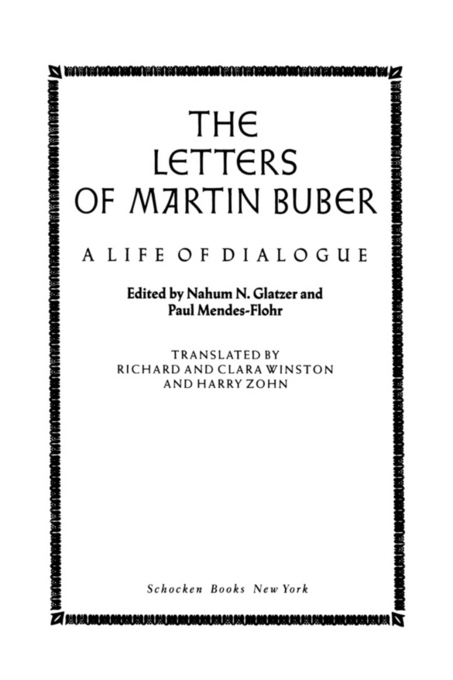Copyright 1991 by Schocken Books Inc.
All rights reserved under International and Pan-American Copyright Conventions. Published in the United States by Schocken Books Inc., New York, and simultaneously in Canada by Random House of Canada Limited, Toronto. Distributed by Pantheon Books, a division of Random House, Inc., New York.
Photographs between are reprinted by permission of the Martin Buber Archives of the Jewish National and University Library in Jerusalem, unless otherwise specified.
Martin Bubers letter to Gandhi, dated February 1939, is reprinted from A Land of Two Peoples: Martin Buber on Jews and Arabs, edited with commentary by Paul R. Mendes-Flohr. Copyright 1983 by Oxford University Press, Inc. Reprinted by permission of Oxford University Press and the Estate of Martin Buber.
Library of Congress Cataloging-in-Publication Data
Buber, Martin, 18781965.
[Briefwechsel] aus sieben Jahrzehnten. [English]
The letters of Martin Buber / edited by Nahum N. Glatzer and Paul
Mendes-Flohr: translated by Richard and Clara Winston and Harry Zohn.
p. cm.
Translation of: Briefwechsel aus sieben Jahrzehnten.
eISBN: 978-0-8041-5013-2
1. Buber, Martin,18781965 Correspondence. 2. PhilosophersCorrespondence. 3. Scholars, JewishCorrespondence. 4. ZionistsCorrespondence. I. Glatzer, Nahum Norbert. 1903. II. Mendes-Flohr, Paul R. III. Winston, Richard. IV. Winston, Clara. V. Zohn, Harry. VI. Title.
B3213.B84A4 1991
296.3092dc20
[B] 90-53433
v3.1
Publishers Note
This edition of The Letters of Martin Buber is based on the three-volume German edition Martin Buber: Briefwechsel aus sieben Jahrzehnten, edited by Grete Schaeder and published by Verlag Lambert Schneider (Heidelberg, 1972, 1973, and 1975). The English edition includes abridged versions of Ms. Schaeders biographical sketch and the preface by Ernst Simon.
The letters for this edition were selected and edited by Nahum N. Glatzer and Paul Mendes-Flohr.
CONTENTS
FOREWORD
by Paul Mendes-Flohr
This edition of Martin Bubers correspondence was initiated by the late Nahum N. Glatzer (190390). It is based on the three-volume German edition Martin Buber: Briefwechsel aus sieben Jahrzehnten (Heidelberg, 197275), edited by Grete Schaeder, a German scholar, in consultation with the executor of Bubers literary estate, Ernst Akiva Simon (18991988) of Jerusalem. In selecting the correspondence from the more than 40,000 letters collected at the Martin Buber Archiveshoused at the Jewish National and University Library, JerusalemDrs. Schaeder and Simon were assisted by the director of the archives and Bubers former secretary, Margot Cohn; Bubers son, Rafael Buber; and Gabriel Stern, a scholar and close associate of Buber during his years in Jerusalem. Theirs was no mean task. The story of their labors and collective effort is related by Ernst Simon in his preface to the German edition of the correspondence, which is included in this volume in slightly abridged form.
Nahum Glatzer was also a close associate of Buber, particularly during the 1920s, when he served as a research assistant on a compendium of hasidic tales edited jointly by Buber and the Hebrew writer Shmuel Yosef Agnon. Repeatedly interrupted, this monumental project unfortunately never came to fruition. Glatzer later served as secretary and assistant to Buber and Franz Rosenzweig in their German translation of the Hebrew Bible. Glatzer and Buber were also colleagues on the faculty of the Freies Jdisches Lehrhaus, founded in 1920 by Franz Rosenzweig in Frankfurt am Main. Upon completing his doctoral dissertation under Bubers supervision, Glatzer succeeded his mentor in 1932 in the lectureship in the Study of Jewish Religion and Ethics at the University of Frankfurt. As is attested in the present volume, he corresponded with Buber throughout the years. Glatzer thus brought to the editing of Bubers correspondence a rich and intimate knowledge of the man and his thought.
Sensitive to the cultural background and concerns of the contemporary English-speaking audience, Glatzer made the initial selection of letters to be included in this edition with consummate care. He chose and edited letters primarily written in German, but also in French and Hebrew. He added letters from Bubers correspondence with Franz Kafka and the poetwho was later to become Bubers son-in-lawLudwig Strauss.
Glatzer also supervised the enormous and immensely arduous task of translating the correspondence, which took many years more to complete than anticipated because of the deaths midway in the project of the original translators, Richard and Clara Winston, and the need to find a successor, Harry Zohn, who most ably completed the translation. Unfortunately, during the intervening period Glatzer became increasingly frail and was unable to carry on. With his consent, Bonny Fetterman, senior editor of Schocken Books, invited me to assume the editorial responsibility for the volume. I accepted the assignment as an occasion to express my esteem and affection for Professor Glatzer, under whose direction I wrote my dissertation (on Buber) at Brandeis University during the early 1970s.
What remained was to review the translation and to make the necessary emendations and deletions. On the instruction of the publisher, I also sought to abridge the selection; in several cases, however, I added letters not included by Glatzer. These letters were graciously translated by Gabrielle Shalit of Jerusalem. On the basis of the notes in the German edition and some memos prepared by Glatzer, I wrote the annotations, keeping in mind, as Glatzer had, that the volume is addressed to an audience which is presumably not as intimate as the German reading public with the issues, personalities, and events discussed or alluded to in the correspondence.
It is with a special sense of gratitude that I acknowledge the assistance of Margot Cohn, the director of the Martin Buber Archives at the Jewish National and University Library in Jerusalem. With graciousness and understanding, she gave my numerous requests immediate attention, helping me to locate letters, photographs, and obscure information. I also wish to thank Beverly Colman for her meticulous copyediting and Bonny Fetterman for her patience, professional guidance, and friendship.
Professor Glatzer passed away in March 1990, just a fortnight shy of his eighty-seventh birthday. I had hoped he would see this volume, on which he labored for so many years, in print. Alas, this was not possible. I must now dedicate my own modest efforts to his memory. As my teacher, he taught me that scholarship is first and foremost a craft, and, accordingly, requires a careful and caring attention to detail, boundless diligence, and an insistence on perfectionor a single dedication to truthfulness and exactitude. Above all, as artisans of matters spiritual, scholars labor out of love, regarding themselves but as servants of both the vessel they shape and of those who are to drink from it. I trust my contribution to this volume reflects, however faintly, the exemplary standards that Nahum Glatzer embodied in his work. May his memory be a blessing.
March 1990
PREFACE TO THE GERMAN EDITION
by Ernst Simon
Until extreme old age, Martin Buber wrote almost all his letters by hand. He did not like dictating, and he particularly disliked dictating letters, aside from business letters, which called for a copy. What he always sought was establishment of a direct relationship with the other person, yet even in conversation this did not come easily to him. He put much effort into the task and with the passing years became more and more practiced at itso much so that, at the end, as Grete Schaeder has shown, his method of achieving that relationship was in danger of congealing into a mechanical technique. The Thou that becomes habitual is soon changed into an It.


